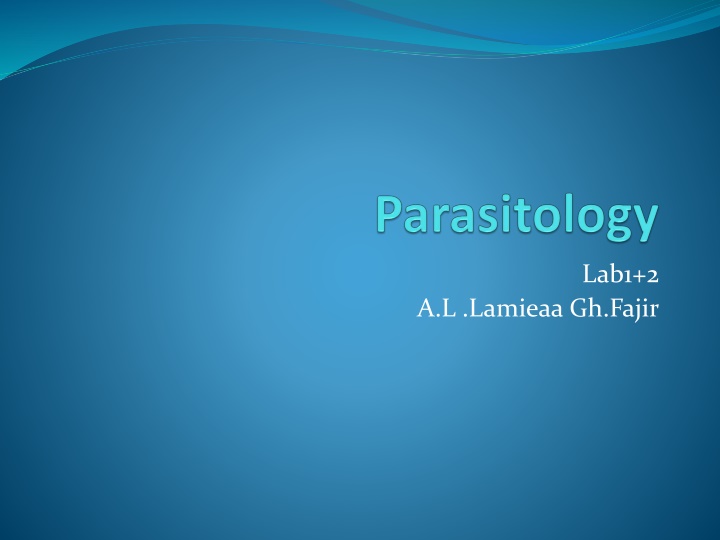
Parasitology and Host-Parasite Relationships
Exploring the world of parasites, Parasitology deals with organisms that live on or within human hosts, causing diseases. Learn about different types of parasites, host-parasite relationships, and modes of infection in this informative guide.
Download Presentation

Please find below an Image/Link to download the presentation.
The content on the website is provided AS IS for your information and personal use only. It may not be sold, licensed, or shared on other websites without obtaining consent from the author. If you encounter any issues during the download, it is possible that the publisher has removed the file from their server.
You are allowed to download the files provided on this website for personal or commercial use, subject to the condition that they are used lawfully. All files are the property of their respective owners.
The content on the website is provided AS IS for your information and personal use only. It may not be sold, licensed, or shared on other websites without obtaining consent from the author.
E N D
Presentation Transcript
Lab1+2 A.L .Lamieaa Gh.Fajir
Parasitology :is the branch of biology dealing with the study of organisms (parasites) which live temporarily or permanently, on or within the human body (host). Parasites often cause important diseases of humans and animals. Parasitology traditionally has included the study of three major groups : - parasitic protozoa parasitic helminths (worms) arthropods that directly cause disease or act as vectors of various pathogens.
Host-Parasite relationship The relationship between two living organisms may be one of the following:- Symbiosis:- Mutual benefit , and the two organisms cannot live independently. Commensalisms:- One organism benefits (commensal) while the other (host) is unaffected. It may be called a non-pathogenic parasite. Parasitism:- One organism (parasite) lives at the expense of the other (host) which usually suffer from the association. It is called a pathogenic parasite.
Types of parasite Ectoparasite:- Live outside the body of the host. e.g. Lice Endoparasite:-Live inside the host. e.g. most of human parasite. Facultative Parasite:- Capable of leading both a free-living and a parasitic existence (live parasitically or none parasitically). Obligate Parasite:- Completely dependent upon its host and cannot lead a free life. Temporary Parasite:- Parasitic only during part of its life cycle. Permanent Parasite:- Live parasitically during the whole life cycle. Accidental parasite when a parasite attacks an unnatural host and survives.(occur in abnormal host). Pseudoparasite:- A certificate mistaken as a parasite. Specific Parasite:-Occurs in one particular host. Pathogenic Parasite:-Causing injury to the host.
Types of hosts 1. Definitive host ( final or terminal) a host that harbors a parasite in the adult stage or where the parasite undergoes a sexual method of reproduction. 2. Intermediate host- harbors the larval stages of the parasite or an asexual cycle of development takes place. 3. Temporary host the host which harbors the parasite for a short time. 4. Reservoir host a host that makes the parasite available for the transmission to another host and is usually not affected by the infection. 5. Natural host a host that is naturally infected with certain species of parasite. 6. Accidental host a host that is under normal circumstances not infected with the parasite. 7. The vector is an organism which belong to the arthropods or insect which transmit the parasite , bacteria and viruses from one host to another
Modes of infection Filth-borne or contaminative - where personal hygiene and community sanitation lacking. Infectious stages remain viable for long periods in contaminated soil. Soil or water-borne - water or dirt which can contain eggs, etc.; Larvae can penetrate skin of bare feet or enter skin in infested water. Food-borne - inadequately cooked beef, pork, fish. Arthropod-borne - the most difficult of all to control. Mosquitoes transmitting malaria, etc.
Types of specimens which can be examined for diagnosis of parasites feces (used to detect lumen dwelling parasites of gastrointestinal tract), sputum (used to detect parasites of pulmonary tract), urine (used to detect parasites of genitourinary tract). Blood - usual specimen for detection of blood and tissue parasites, along with tissue biopsies, aspirates, etc.
Stool stool or feces are composed of the following materials: Waste residue of indigestible material (cellulose during the previous 4 days). Bile pigments and salts. Intestinal secretions, including mucus. Leukocytes that migrate from the bloodstream. Water and electrolytes. Epithelial cells that have been shed. Large numbers of bacteria. and Inorganic material(10-20%) chiefly calcium and phosphates. Undigested and unabsorbed food(normally present in very small amount).
Collection samples of Stool To ensure that good specimens are provided for examination, it is important to note the following points 1. A clean dry container must be used for the collection of fecal samples. Urine and water will destroy trophozoites, if present, and the presence of dirt also causes identification problems. 2. Ideally the specimen should be brought to the lab as soon as it is passed, to avoid deterioration of protozoa and alterations of the morphology of protozoa and helminths. 3. The specimen container should be clearly labelled with the patients name, date, and time of passage of the specimen. 4. An amount of stool adequate for parasite examination should be collected and a repeat sample requested if too little is supplied. 5. Diarrheal specimens, or those containing blood and mucus, should be examined promptly on arrival in the laboratory. The specimens may contain motile amoebic or flagellate trophozoitesand may round up and thus be missed if examination is delayed
Preservation of specimen When there is a time lag - from the time of specimen passage until reaching to the lab. Done mainly to preserve the morphology , motility ( wet mount ) of the parasite: PVA(Polyvinyl alcohol) for trophozoites stage of protozoa . MIF( Merthiolate Iodine Formalin)---> for helminth s egg, Larvae, Protozoan cyst, oocysts . SAF(sodium acetate acetic acid formalin)---> for helminth s eggs, larvae , protozoan trophozoite, cyst, oocyst Microsporidia.
